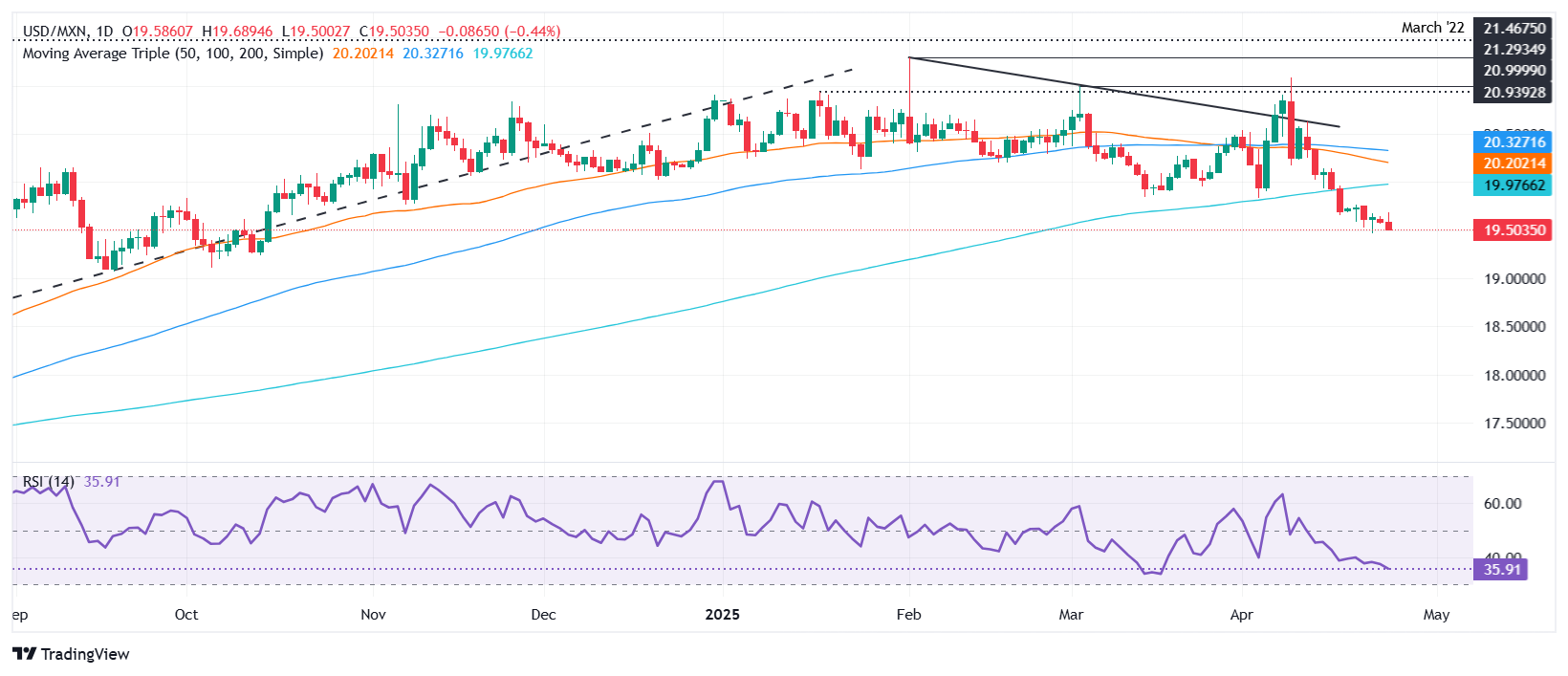Created
: 2025.04.26














![]() 2025.04.26 06:12
2025.04.26 06:12
The Mexican Peso extended its gains against the US Dollar for the second consecutive day, poised to finish the week with gains of 0.89%, sponsored by an improvement in risk appetite and better-than-expected Mexico economic data. At the time of writing, the USD/MXN trades at 19.52, down 0.32%.
Wall Street closed with gains in Friday's session, even though US President Donald Trump delivered contradictory remarks about China. Overnight news for American traders revealed Beijing's willingness to reduce tariffs on US products. Despite this, Trump said he won't lower tariffs unless "they give us something substantial."
The Instituto Nacional de Estadistica Geografia e Informatica (INEGI) revealed that the Mexican economy grew in February, contrary to forecasts, which expected a moderate expansion.
Meanwhile, in the US, the University of Michigan (UoM) 's April Consumer Sentiment index deteriorated sharply, posting its fourth lowest reading since the late 1970s, an indication that Americans grew doubtful about the economic outlook.
Therefore, the USD/MXN edged lower, propelled by goodish Mexico's data. However, next week, INEGI will release the Gross Domestic Product (GDP) Growth Rate for the first quarter of 2025. A negative reading would confirm that the economy is in a technical recession.
Price action suggests the USD/MXN is bearishly biased and might continue its downtrend, once it registers a daily close below 19.50. In that outcome, the next support would be 23's low of 19.46, the current year-to-date (YTD) low, followed by the 19.00 psychological figure.
If buyers want to push prices higher, they must reclaim the 200-day SMA at 19.93, followed by the 20.00 figure. A breach of the latter will expose the confluence of the April 14 high and the 50-day SMA near 20.25-20.29 before testing the 100-day SMA at 20.33.

The Mexican Peso (MXN) is the most traded currency among its Latin American peers. Its value is broadly determined by the performance of the Mexican economy, the country's central bank's policy, the amount of foreign investment in the country and even the levels of remittances sent by Mexicans who live abroad, particularly in the United States. Geopolitical trends can also move MXN: for example, the process of nearshoring - or the decision by some firms to relocate manufacturing capacity and supply chains closer to their home countries - is also seen as a catalyst for the Mexican currency as the country is considered a key manufacturing hub in the American continent. Another catalyst for MXN is Oil prices as Mexico is a key exporter of the commodity.
The main objective of Mexico's central bank, also known as Banxico, is to maintain inflation at low and stable levels (at or close to its target of 3%, the midpoint in a tolerance band of between 2% and 4%). To this end, the bank sets an appropriate level of interest rates. When inflation is too high, Banxico will attempt to tame it by raising interest rates, making it more expensive for households and businesses to borrow money, thus cooling demand and the overall economy. Higher interest rates are generally positive for the Mexican Peso (MXN) as they lead to higher yields, making the country a more attractive place for investors. On the contrary, lower interest rates tend to weaken MXN.
Macroeconomic data releases are key to assess the state of the economy and can have an impact on the Mexican Peso (MXN) valuation. A strong Mexican economy, based on high economic growth, low unemployment and high confidence is good for MXN. Not only does it attract more foreign investment but it may encourage the Bank of Mexico (Banxico) to increase interest rates, particularly if this strength comes together with elevated inflation. However, if economic data is weak, MXN is likely to depreciate.
As an emerging-market currency, the Mexican Peso (MXN) tends to strive during risk-on periods, or when investors perceive that broader market risks are low and thus are eager to engage with investments that carry a higher risk. Conversely, MXN tends to weaken at times of market turbulence or economic uncertainty as investors tend to sell higher-risk assets and flee to the more-stable safe havens.
![]()
Created
: 2025.04.26
![]()
Last updated
: 2025.04.26

FXStreet is a forex information website, delivering market analysis and news articles 24/7.
It features a number of articles contributed by well-known analysts, in addition to the ones by its editorial team.
Founded in 2000 by Francesc Riverola, a Spanish economist, it has grown to become a world-renowned information website.
We hope you find this article useful. Any comments or suggestions will be greatly appreciated.
We are also looking for writers with extensive experience in forex and crypto to join us.
please contact us at [email protected].
Disclaimer:
All information and content provided on this website is provided for informational purposes only and is not intended to solicit any investment. Although all efforts are made in order to ensure that the information is correct, no guarantee is provided for the accuracy of any content on this website. Any decision made shall be the responsibility of the investor and Myforex does not take any responsibility whatsoever regarding the use of any information provided herein.
The content provided on this website belongs to Myforex and, where stated, the relevant licensors. All rights are reserved by Myforex and the relevant licensors, and no content of this website, whether in full or in part, shall be copied or displayed elsewhere without the explicit written permission of the relevant copyright holder. If you wish to use any part of the content provided on this website, please ensure that you contact Myforex.
Myforex uses cookies to improve the convenience and functionality of this website. This website may include cookies not only by us but also by third parties (advertisers, log analysts, etc.) for the purpose of tracking the activities of users. Cookie policy